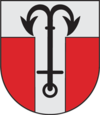Salacgrīva
| Salacgrīva | |||
|---|---|---|---|
| Town | |||

Street in Salacgrīva
|
|||
|
|||
| Location in Latvia | |||
| Coordinates: 57°45′N 24°21′E / 57.750°N 24.350°ECoordinates: 57°45′N 24°21′E / 57.750°N 24.350°E | |||
| Country |
|
||
| District | Salacgrīva Municipality | ||
| Town rights | 1928 | ||
| Government | |||
| • Mayor | Dagnis Straubergs | ||
| Area | |||
| • Total | 12.57 km2 (4.85 sq mi) | ||
| • Rural territory | 312.83 km2 (120.78 sq mi) | ||
| Population | |||
| • Total | 3,060 | ||
| • Density | 260/km2 (700/sq mi) | ||
| Time zone | EET (UTC+2) | ||
| • Summer (DST) | EEST (UTC+3) | ||
| Postal code | LV-403(2-4) | ||
| Calling code | +371 640 | ||
| Number of city council members | 15 | ||
Salacgrīva (![]() pronunciation is a town in the northern part of Vidzeme's region, Latvia. The centre of the area surrounding Salacgriva is the mouth of Salaca River, and the town's name literally means "Mouth of Salaca" in Latvian.
pronunciation is a town in the northern part of Vidzeme's region, Latvia. The centre of the area surrounding Salacgriva is the mouth of Salaca River, and the town's name literally means "Mouth of Salaca" in Latvian.
The distance from Salacgriva to the capital of Latvia - Riga is 103 km, to Limbaži – 50 km, to Valmiera – 95 km. Export of timber, wood-working industry, food production and trade are the most important factors in the economy of Salacgriva.
For the first time Salacgriva was known as a locality in early 5th century, when Livonians created their settlement of Saletsa near the mouth of Salaca River. Several centuries later the knight’s castle was built in honor of Bishop Albert on the right bank of Salaca River. It was attacked several times during the Livonian war, and for this reason by the end of the 17th century the castle had been severely damaged and it subsequently collapsed. The canal where the vessels sailed around the castle mound can still be seen in Salacgriva.
Evolution of Salacgriva went hand in hand with the development of coastal shipping in the Gulf of Riga. To improve the accessibility for larger vessels, the riverbed of Salaca was deepened and a pier of boulders was built in the mouth of the river. Salacgriva became an important transhipment point for the production of Northen Vidzeme – timber, linen, different crops – for it to be transported to Parnu and Riga. Around this time, about 200 vessels entered the port, consequently promoting growth of the town and increase in the number of its inhabitants. Therefore, by the end of the 19th century there were more than 70 residential buildings and 40 warehouses. At the beginning of the 20th century, the flow of goods to Salacgriva decreased, due to the rail infrastructure that was developed in Vidzeme and the fact that the majority of products was transported through the newly built port in Ainaži, which had a directly connection to the railway.
...
Wikipedia



